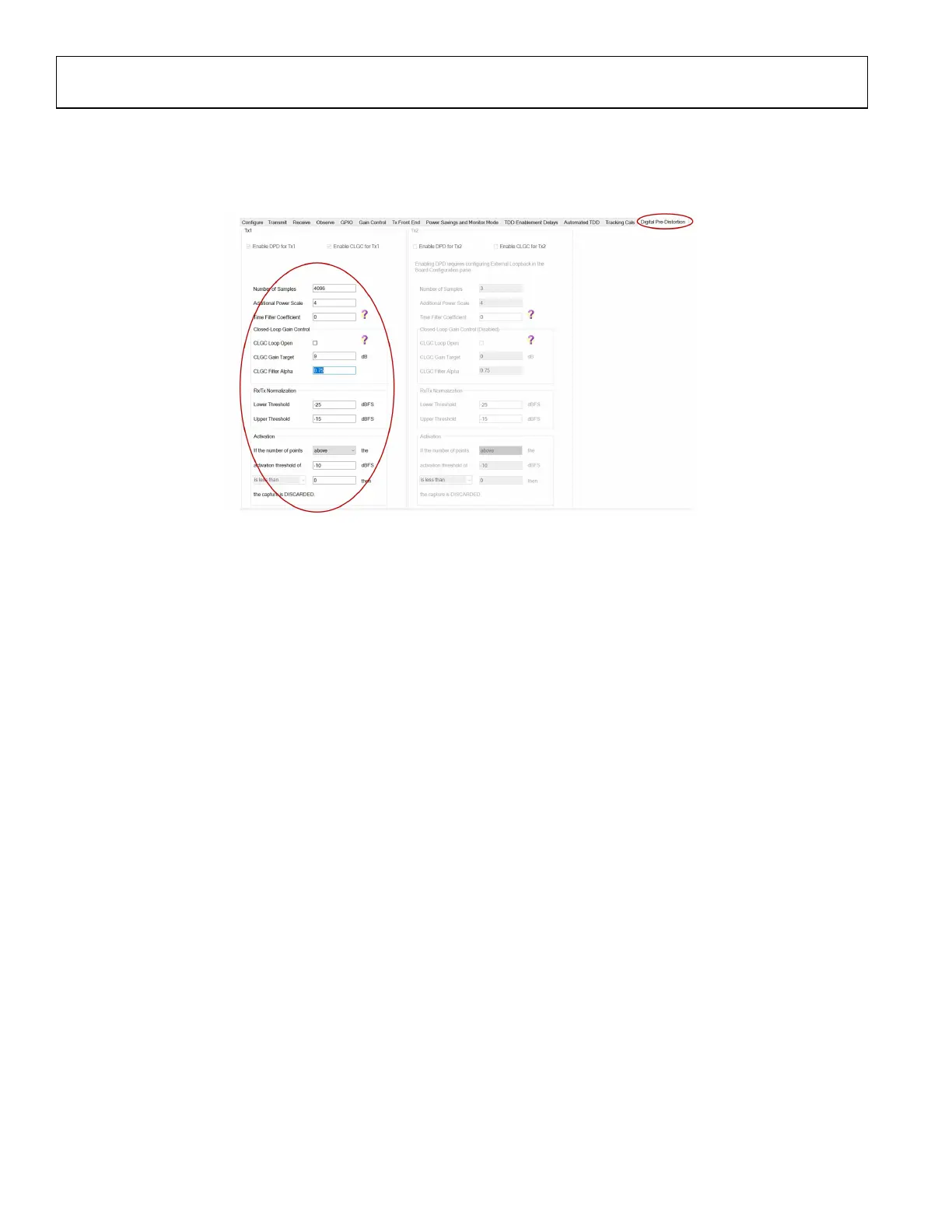UG-1828 Preliminary Technical Data
Rev. PrB | Page 210 of 277
Table 92. RX1B± and RX2B± Impedance Matching Network
Frequency Balun L/C 222
L/C/R
223
L/C 224
L/C/R
226
L/C/R 237
L/C/R 249
L/C/R 250
L/C/R 251
L/C/R 252
L/C 225
L/C/R 227
L/C/R 228
L/C 229
C233
R233
30 MHz – 3
GHz
MiniCircuits
TCM2-33WX+
L222:
DNI
C222:
0.5pF
Murata
(GJM03
Series)
L223: 2.2
nH AVX
Ind
(L0201
series)
C223:
DNI
R223:
DNI
L224:
DNI
C224:
DNI
L226:
DNI
C226:
DNI
R226: 0
Ω
L237: DNI
C237: DNI
R237: DNI
L249/250:
DNI
C253/254:
DNI
R222/224:
0 Ω
L251/252:
DNI
C251/252:
DNI
R225/229:
DNI
L225:
DNI
C225:
DNI
L227/228: DNI
C227/228: 470
pF Murata
(GRM03
Series)
R227/228: DNI
L229:
DNI
C229:
DNI
C233:
DNI
R233:
DNI
3 GHz – 6
GHz
Johanson
4400
L222:
DNI
C222:
DNI
Note:
C257:
0.2pF
Murata
(GJM03
Series)
L223: 1.2
nH AVX
Ind
(L0201
series)
C223:
DNI
R223:
DNI
L224:
DNI
C224:
DNI
L226:
DNI
C226:
DNI
R226:
DNI
L237: DNI
C237: DNI
R237: 0 Ω
L249/250:
DNI
C249/250:
DNI
R222/224:
DNI
L251/252:
0.33 nH AVX
Ind
(L0201 series)
C251/252:
DNI
R251/252:
DNI
L225:
CNI
C225:
0.1pF
Murata
(GRM03
Series)
L227/228: 1.0
nH AVX Ind
(L0201 series)
C227/228: DNI
R227/228: DNI
L229:
DNI
C229:
0.1pF
Murata
(GRM03
Series)
C233:
1.4pF
Mura
ta
(GJM
03
Series
)
R233:
DNI
30 MHz – 1
GHz
MiniCircuits
TCM2-33WX+
L222:
DNI
C222:
DNI
L223:
DNI
C223:
DNI
R223: 0
Ω
L224:
DNI
C224:
DNI
L226:
DNI
C226:
DNI
R226: 0
Ω
L237: DNI
C237: DNI
R237: DNI
L249/250:
DNI
C249/250:
DNI
R222/224:
0 Ω
L251/252:
DNI
C251/252:
DNI
R225/229:
DNI
L225:
DNI
C225:
DNI
L227/228: DNI
C227/228: 470
pF Murata
(GRM03
Series)
R227/228: DNI
L229:
DNI
C229:
DNI
C233:
DNI
R233:
DNI
625 MHz –
2.8 GHz
Johanson
1720BL15B0100
L222:
DNI
C222:
0.7pF
Murata
(GJM03
Series)
L223: 2.7
nH AVX
Ind
(L0201
series)
C223:
DNI
R223:
DNI
L224:
DNI
C224:
0.4pF
Murata
(GJM03
Series)
L226:
DNI
C226:
DNI
R226:
DNI
L237: DNI
C237: DNI
R237: 0 Ω
L249/250:
DNI
C249/250:
DNI
R222/224:
DNI
L251/252:
DNI
C251/252:
DNI
R225/229: 0
Ω
L225:
DNI
C225:
DNI
L227/228: DNI
C227/228:
470pF Murata
(GRM03
Series)
R227/228: DNI
L229:
DNI
C229:
DNI
C233:
DNI
R233:
DNI
2.8 GHz – 5
GHz
Anaren
BD3150L50100AA
F
L222:
DNI
C222:
0.5pF
Murata
(GJM03
Series)
L223: 1.5
nH AVX
Ind
(L0201
series)
C223:
DNI
R223:
DNI
L224:
DNI
C224:
0.5pF
Murata
(GJM03
Series)
L229:
DNI
C229:
DNI
R229:
DNI
L237: DNI
C237: DNI
R237: 0 Ω
L249/250:
DNI
C251/252:
DNI
C249/250:
DNI
R222/224:
DNI
L251/252:
DNI
C251/252:
100pF
Murata
(GRM03
Series)
R251/252:
DNI
L225:
DNI
C225:
DNI
L227/228: 0.82
nH AVX Ind
(L0201 series)
C227/228: DNI
R227/228: DNI
L229:
DNI
C229:
DNI
C233:
DNI
R233:
DNI
4.5 GHz– 6
GHz
Johanson
5400BL15B100
L222:
DNI
C222:
0.2pF
Murata
(GJM03
Series
L223: 1.2
nH AVX
Ind
(L0201
series)
C223:
DNI
R223:
DNI
L224:
DNI
C224:
0.2pF
Murata
(GJM03
Series
L226:
DNI
C226:
DNI
Series
R226:
DNI
L237: DNI
C237: DNI
R237: 0 Ω
L249/250:
DNI
C249/250:
DNI
R222/224:
DNI
L251/252:
DNI
C251/252:
30pF Murata
(GRM03
Series)
R251/252:
DNI
L225:
DNI
C225:
DNI
L227/228: 0.68
nH AVX Ind
(L0201 series)
C227/228: DNI
R227/228: DNI
L229:
DNI
C229:
DNI
C233:
DNI
R233:
DNI
RECEIVER RF PORT IMPEDANCE MATCH MEASUREMENT DATA
Receiver RF Port Impedance Match Measurement Data for 30 MHz to 3 GHz Band Match
Return loss was measured on RX1(2)A and RX1(2)B RF ports of eval boards and plotted below; blue and pink curves represent four
different return loss measurements and black dotted line represents simulated return loss curve on Figure 203 and Figure 204. Simulated
insertion loss curve including balun loss is plotted on Figure 205.

